Assessing the Seismic Behavior of Rammed Earth Walls with an L-Form Cross-Section
Abstract
:1. Introduction
2. Numerical Model
2.1. Behavior Laws of Intralayers
- is the initial undamaged elastic modulus,
- is the equivalent plastic strain in tension,
- is the equivalent plastic strain in compression.
2.2. Interlayer Behavior
3. Validation of the Numerical Model by Experimental Results
3.1. Experimental Test
3.2. Identification of Parameters
3.3. Numerical Results
4. Time History Analysis
4.1. Structures Studied
4.2. Nonlinear Dynamic Analysis
4.3. Case of Rectangular Cross-Section Wall
4.4. Case of L-Form Cross-Section Wall
5. Discussions
6. Conclusions and Prospects
Author Contributions
Funding
Conflicts of Interest
References
- Bui, Q.B.; Morel, J.C.; Reddy, B.V.V.; Ghayad, W. Durability of rammed earth walls exposed for 20 years to natural weathering. Build. Environ. 2009, 44, 912–919. [Google Scholar] [CrossRef]
- Bui, Q.B.; Morel, J.C.; Hans, S.; Walker, P. Effect of moisture content on the mechanical characteristics of rammed earth. Constr. Build. Mater. 2014, 54, 163–169. [Google Scholar] [CrossRef] [Green Version]
- Reddy, B.V.V.; Kumar, P.P. Embodied energy in cement stabilized rammed earth walls. Energy Build. 2010, 42, 380–385. [Google Scholar] [CrossRef]
- Walker, P.; Keable, R.; Martin, J.; Maniatidis, V. Rammed earth–design and construction guidelines. In BRE Bookshop; IHS BRE Press: Berkshire, UK, 2005. [Google Scholar]
- Morel, J.C.; Mesbah, A.; Oggero, M.; Walker, P. Building houses with local materials: Means to drastically reduce the environmental impact of construction. Build. Environ. 2001, 36, 1119–1126. [Google Scholar] [CrossRef]
- Soudani, L.; Fabbri, A.; Morel, J.C. Assessment of the validity of some common assumptions in hygrothermal modelling of earth based materials. Energy Build. 2016, 116, 498–511. [Google Scholar] [CrossRef]
- Allinson, D.; Hall, M. Hygrothermal analysis of a stabilized rammed earth test building in the UK. Energy Build. 2010, 42, 845–852. [Google Scholar] [CrossRef]
- Bui, T.T.; Bui, Q.B.; Limam, A.; Maximilien, S. Failure of rammed earth walls: From observations to quantifications. Constr. Build. Mater. 2014, 51, 295–302. [Google Scholar] [CrossRef] [Green Version]
- Bui, T.T.; Bui, Q.B.; Limam, A.; Morel, J.C. Modeling rammed earth wall using discrete element method. Contin. Mech. 2015, 28, 523–538. [Google Scholar] [CrossRef] [Green Version]
- Bui, Q.B. Assessing the rebound hammer test for rammed earth material. Sustainability 2017, 9. [Google Scholar] [CrossRef]
- Cheah, J.S.J.; Walker, P.; Heath, A.; Morgan, T.K.K.B. Evaluating shear test methods for stabilized rammed earth. Constr. Mater. 2012, 165, 325–334. [Google Scholar] [CrossRef]
- Ciancio, D.; Augarde, C. Capacity of unreinforced rammed earth walls subject to lateral wind force: Elastic analysis versus ultimate strength analysis. Mater. Struct. 2013, 46, 1569–1585. [Google Scholar] [CrossRef]
- Miccoli, L.; Oliveira, D.V.; Silva, R.A.; Muller, U.; Schueremans, L. Static behavior of rammed earth: Experimental testing and finite element modeling. Mater. Struct. 2014, 48, 3443–3456. [Google Scholar] [CrossRef]
- Silva, R.A.; Oliveira, D.V.; Miranda, T.; Cristelo, N.; Escobar, M.C.; Soares, E. Rammed earth construction with granitic residual soils: The case study of northern Portugal. Constr. Build. Mater. 2013, 47, 181–191. [Google Scholar] [CrossRef] [Green Version]
- Miccoli, L.; Drougkas, A.; Müller, U. In-plane behavior of rammed earth under cyclic loading: Experimental testing and finite element modelling. Eng. Struct. 2016, 125, 144–152. [Google Scholar] [CrossRef]
- Bui, Q.B.; Hans, S.; Morel, J.C.; Do, A.P. First exploratory study on dynamic characteristics of rammed earth buildings. Eng. Struct. 2011, 33, 3690–3695. [Google Scholar] [CrossRef]
- Gomes, M.I.; Lopes, M.; Brito, J. Seismic resistance of earth construction in Portugal. Eng. Struct. 2011, 33, 932–941. [Google Scholar] [CrossRef] [Green Version]
- El-Nabouch, R.; Bui, Q.B.; Plé, O.; Perrotin, P. Assessing the in-plane seismic performance of rammed earth walls by using horizontal loading tests. Eng. Struct. 2017, 145, 153–161. [Google Scholar] [CrossRef]
- Bui, Q.B.; Bui, T.T.; Limam, A. Assessing the seismic performance of rammed earth walls by using discrete elements. Cogent Eng. 2016, 3, 1200835. [Google Scholar] [CrossRef]
- ABAQUS Version 6.12 Documentation. ABAQUS Analysis User’s Manual 6.12-EF; Dassault Systems Simulia Corp.: Providence, RI, USA, 2013. [Google Scholar]
- El-Nabouch, R.; Bui, Q.B.; Perrotin, P.; Plé, O. Shear parameters of rammed earth material: Results from different approaches. Adv. Mater. Sci. Eng. 2018. [Google Scholar] [CrossRef]
- Foti, D.; Ivorra, S.; Vacca, V. In plane behavior of a masonry stone wall with hexagonal blocks. In Proceedings of the 16th International Brick and Block Masonry Conference (IBMAC 2016), Padova, Italy, 26–30 June 2016; pp. 1587–1591. [Google Scholar]
- Bui, Q.B.; Limam, A.; Bui, T.T. Dynamic discrete element modelling for seismic assessment of rammed earth walls. Eng. Struct. 2018, 175, 690–699. [Google Scholar] [CrossRef]
- Nasiri, E.; Liu, Y. Development of a detailed 3D FE model for analysis of the in-plane behavior of masonry infilled concrete frames. Eng. Struct. 2017, 143, 603–616. [Google Scholar] [CrossRef]
- Lubliner, J.; Oliver, J.; Oller, S.; Oñate, E. A plastic-damage model for concrete. Int. J. Solids Struct. 1989, 25, 299–326. [Google Scholar] [CrossRef]
- Lee, J.; Fenves, G. Plastic-Damage Model for Cyclic Loading of Concrete Structures. J. Eng. Mech. 1998, 124, 892–900. [Google Scholar] [CrossRef]
- Genikomsou, A.S.; Polak, M.A. Finite element analysis of punching shear of concrete slabs using damaged plasticity model in ABAQUS. Eng. Struct. 2015, 98, 38–48. [Google Scholar] [CrossRef]
- Cornelissen, H.A.W.; Hordijk, D.A.; Reinhardt, H.W. Experimental Determination of Crack Softening Characteristics of Normalweight and Lightweight Concrete; HERON; Delft University of Technology: Delft, The Netherlands, 1986; Volume 31. [Google Scholar]
- FIB. FIB Model Code for Concrete Structures; Wiley-VCH Verlag GmbH & Co. KGaA: Weinheim, Germany, 1990. [Google Scholar]
- Feenstra, P.H.; Borst, R. Computational Aspects of Biaxial Stress in Plain and Reinforced Concrete; Delft University Press: Delft, The Netherlands, 1993. [Google Scholar]
- El-Nabouch, R.; Bui, Q.B.; Plé, O.; Perrotin, P. Characterizing the shear parameters of rammed earth material by using a full-scale direct shear box. Constr. Build. Mater. 2018, 171, 414–420. [Google Scholar] [CrossRef]
- Calvi, G.M. A displacement-based approach for vulnerability evaluation of classes of buildings. J. Earthq. Eng. 1999, 3, 411–438. [Google Scholar] [CrossRef]
- Vamvatsikos, D.; Cornell, C.A. Incremental dynamic analysis. Earthq. Engng Struct. Dyn. 2002, 31, 491–514. [Google Scholar] [CrossRef]
- Walker, P.; Dobson, S. Pullout Tests on Deformed and Plain Rebars in Cement-Stabilized Rammed Earth. J. Mater. Civ. Eng. 2001, 13, 291–297. [Google Scholar] [CrossRef]


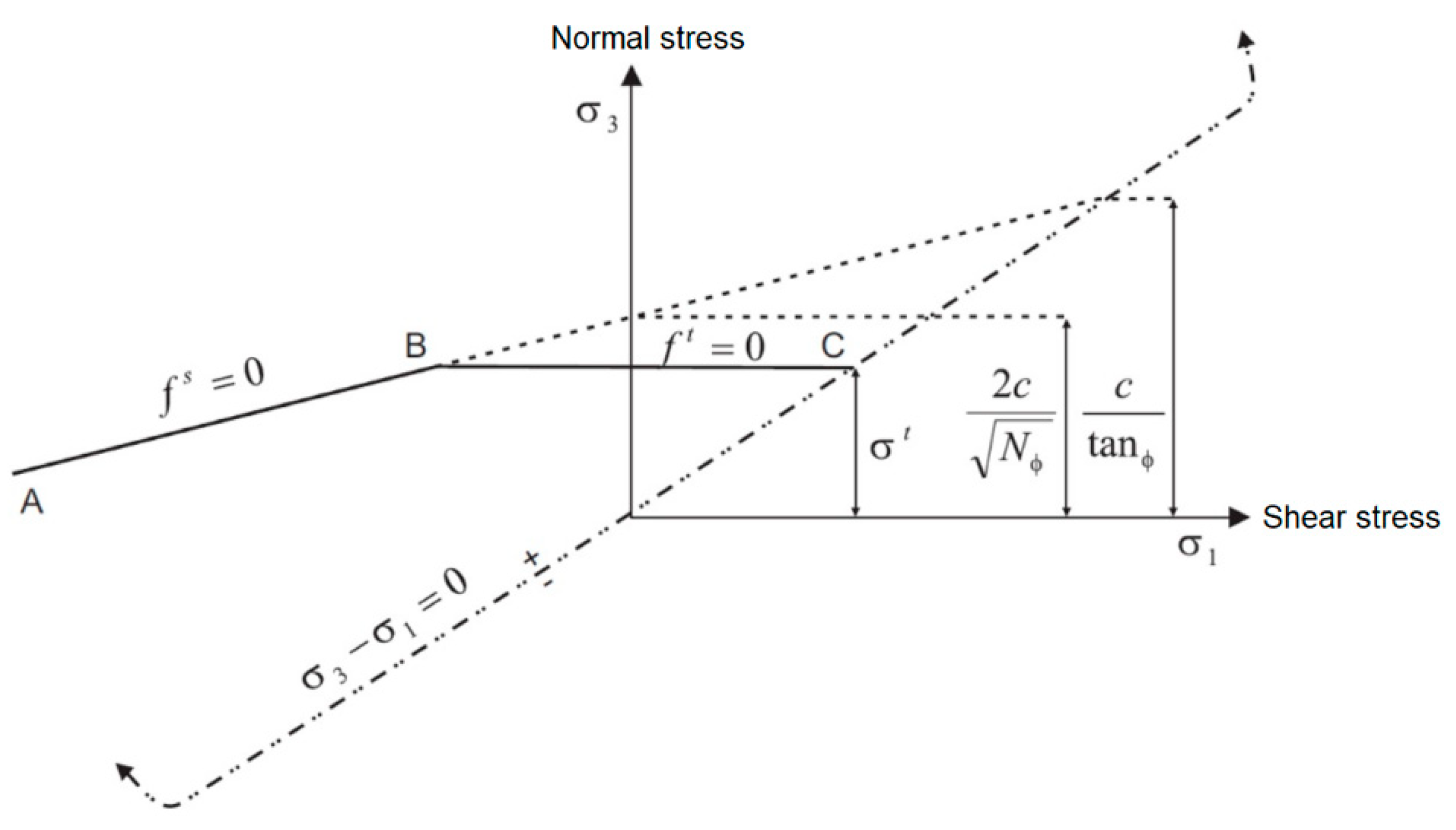
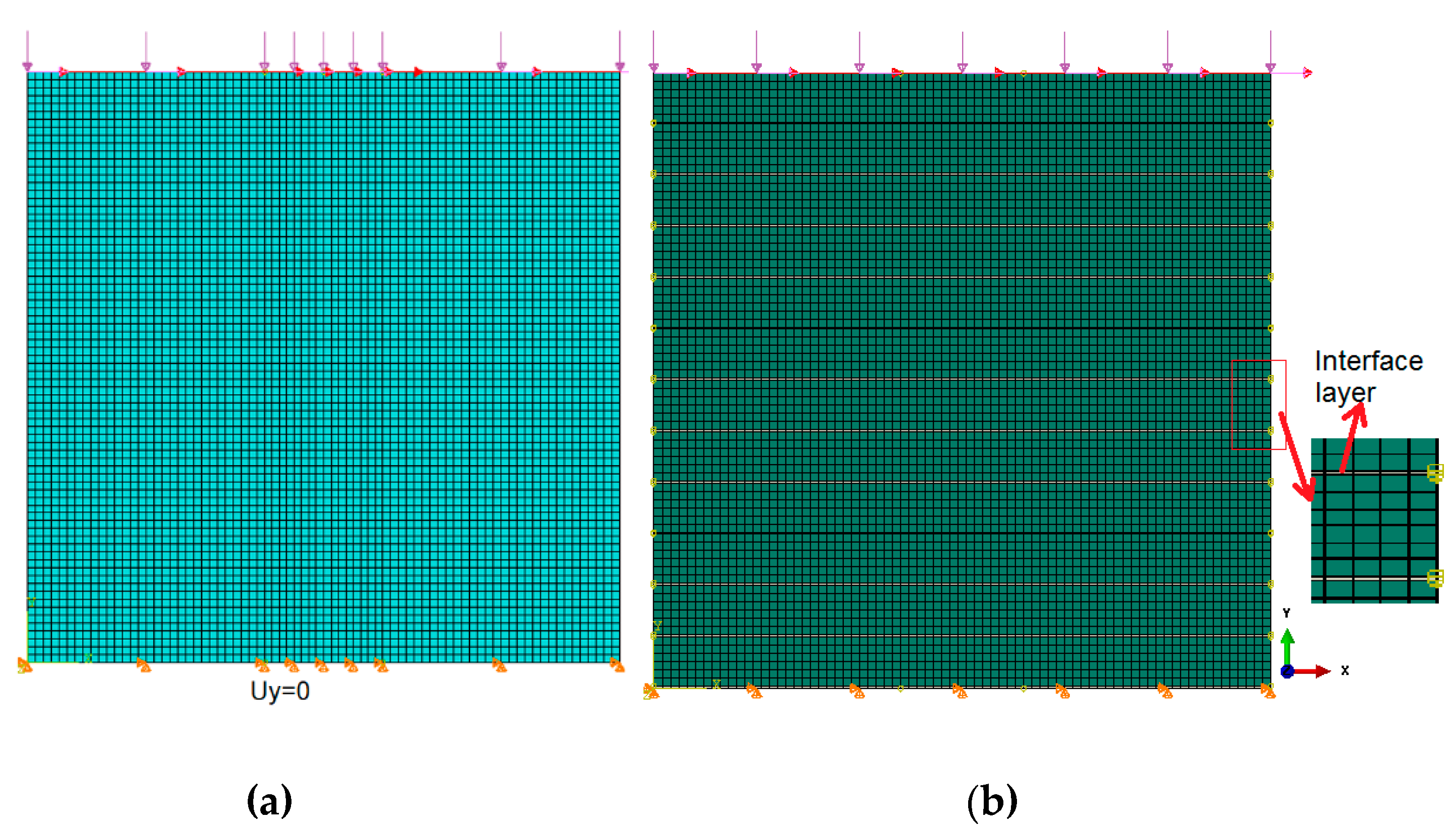

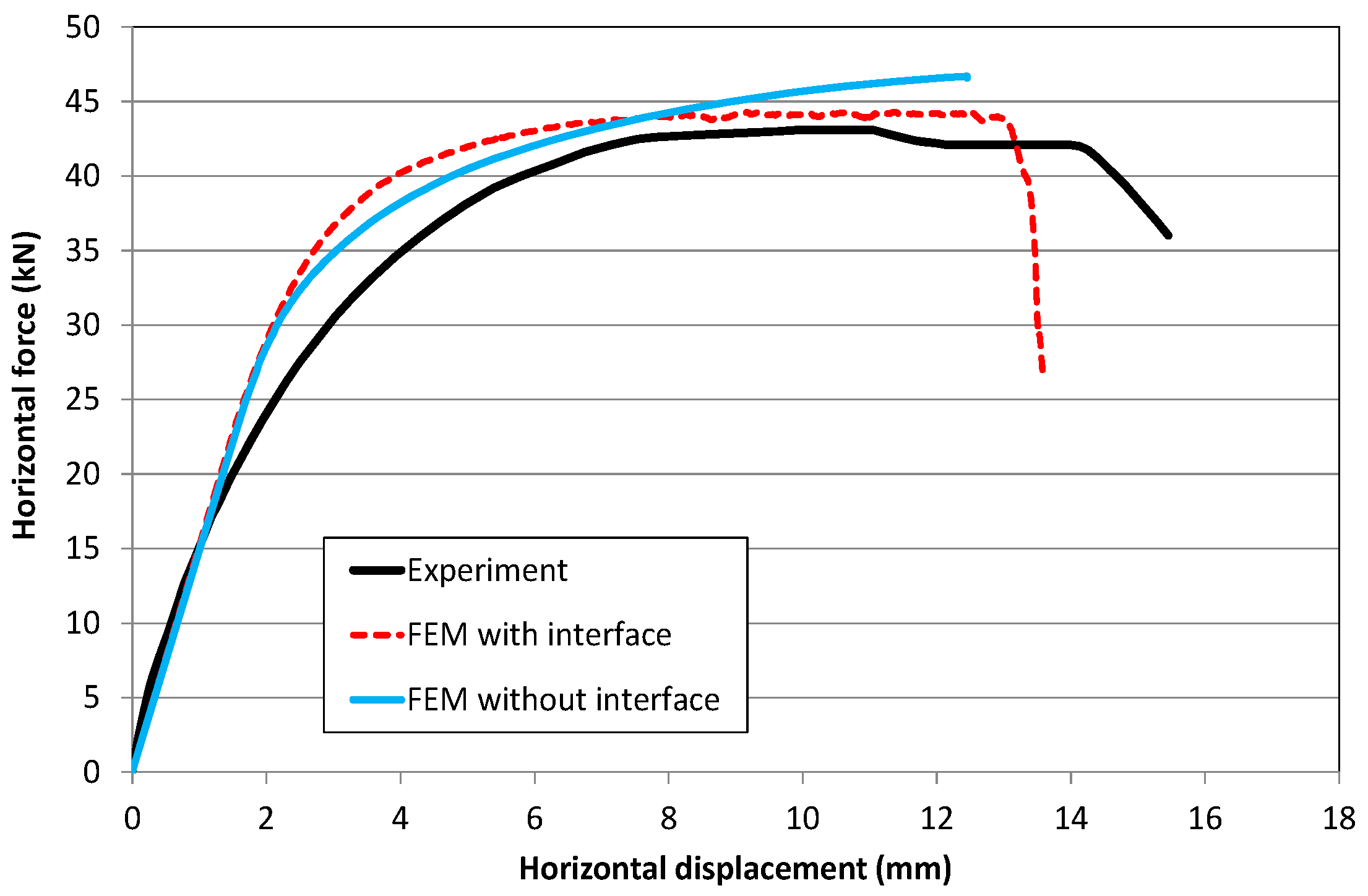
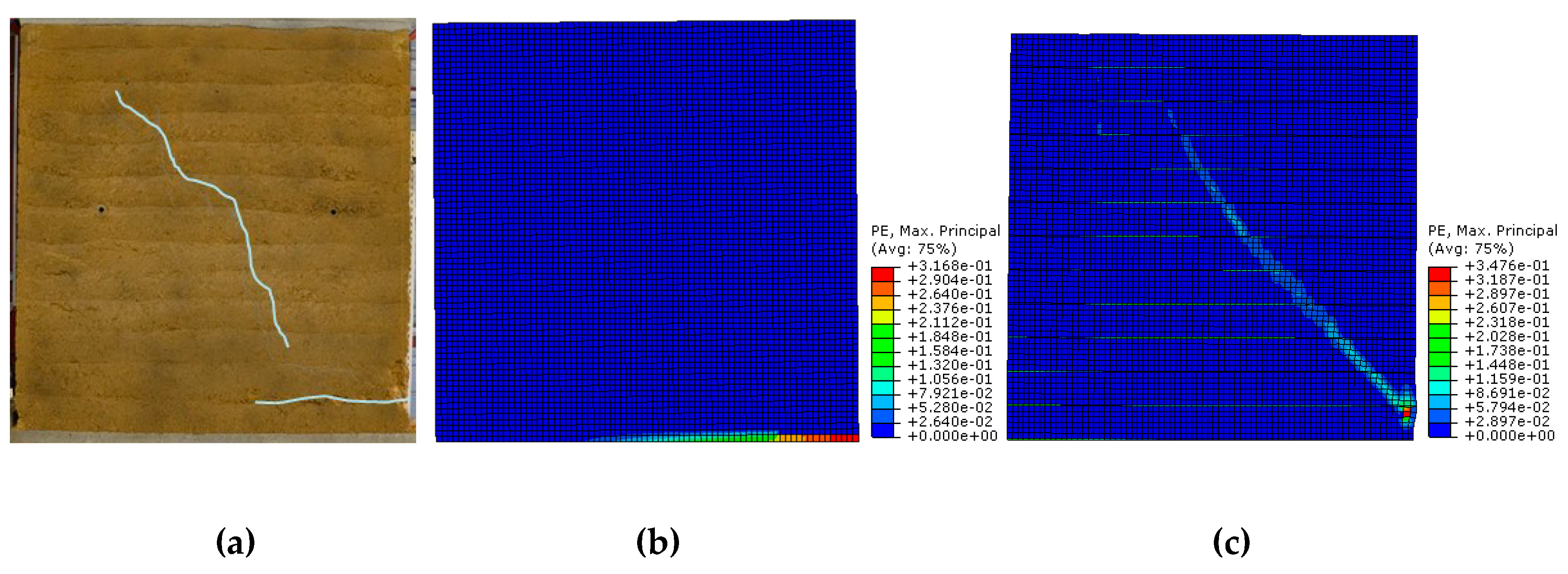




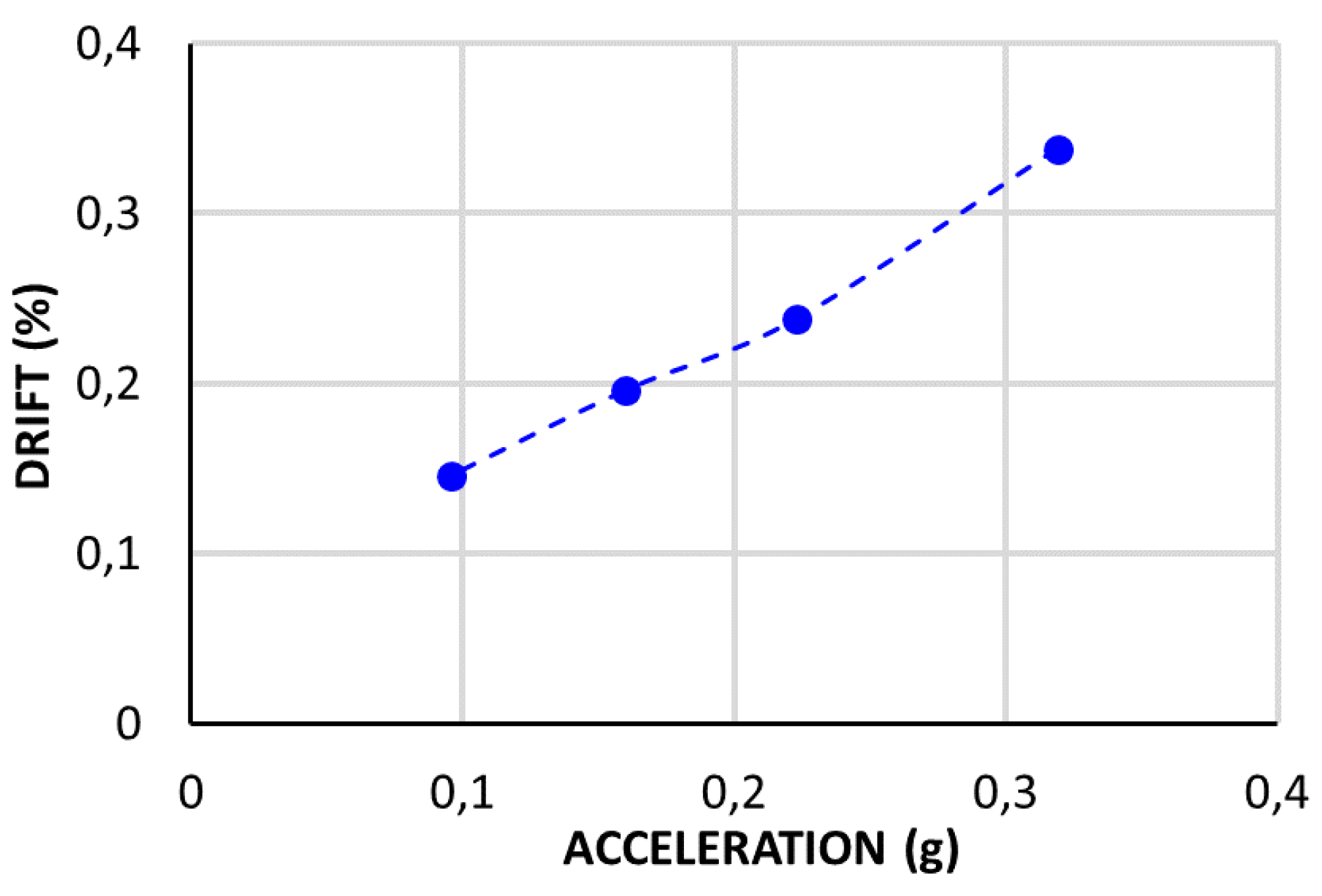
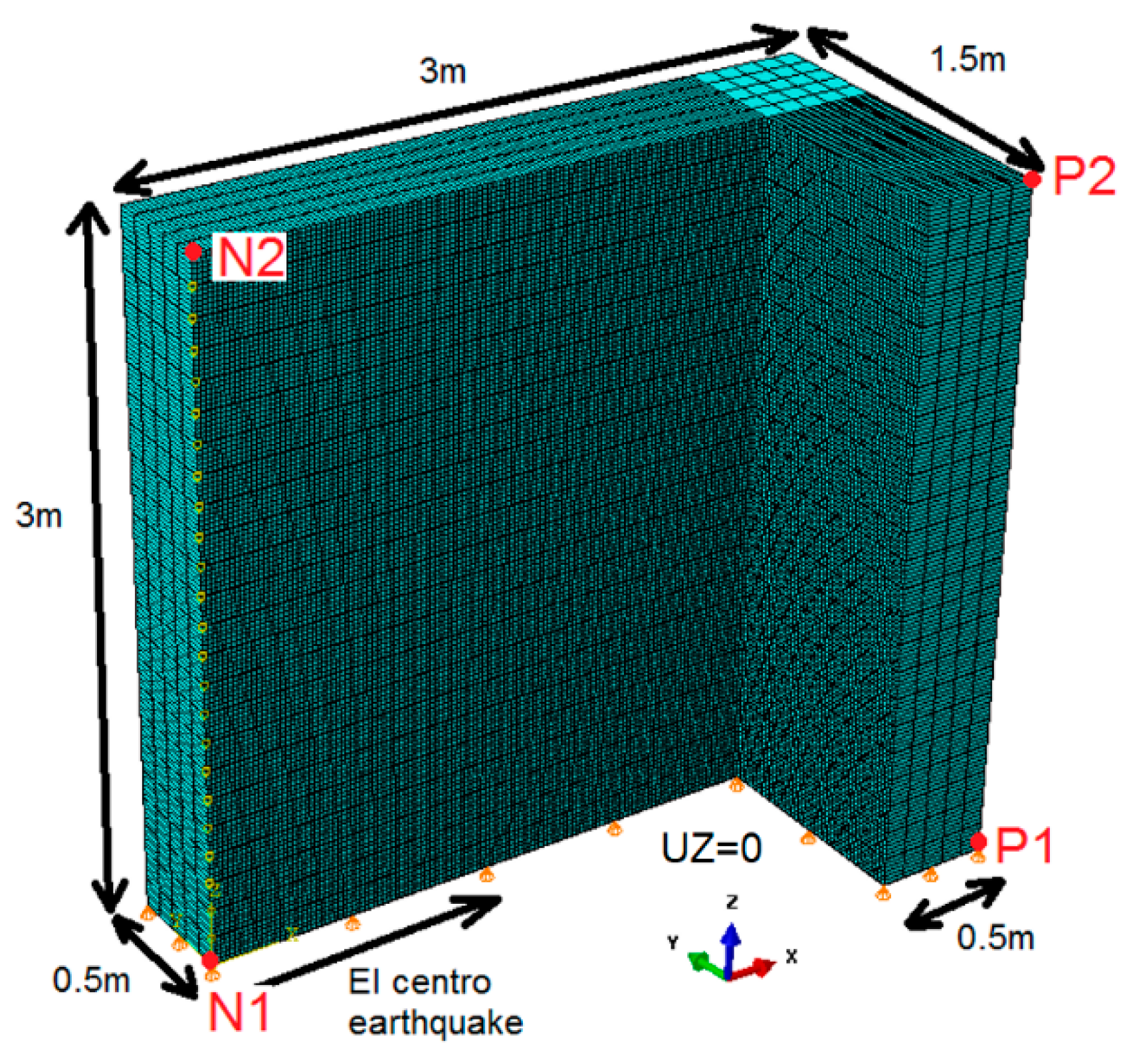






| dmax (mm) | Gf0 (Nmm/mm2) |
|---|---|
| 8 | 0.025 |
| 16 | 0.030 |
| 32 | 0.058 |
| Parameter | Description | Default Value |
|---|---|---|
| Ψ | Dilation angle | User-defined |
| ∈ | Flow potential eccentricity | 0.1 |
| Ratio of initial equibiaxial compressive yield stress to initial uniaxial compressive yield stress | 1.16 | |
| Kc | Ratio of the second stress invariant on the tensile meridian | 0.6667 |
| Max. Relative Displacement | Max. Drift | Max. Principal Strain | |
|---|---|---|---|
| 10.153 mm | 0.338% |  |  |
| amax | Max Principal Strain | |
|---|---|---|
| 0.096 g (30% loading) |  |  |
| 0.160 g (50% loading) |  |  |
| 0.223 g (70% loading) | 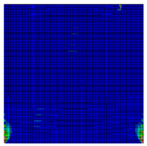 |  |
| 0.319 g (100% loading) | 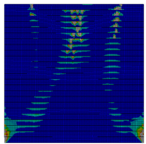 |  |
| 100% Loading (amax = 0.319 g) | 70% Loading (amax = 0.223 g) | 30% Loading (amax = 0.096 g) |
|---|---|---|
 |  |  |
 | 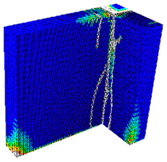 |  |
 |  | 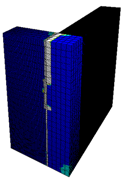 |
© 2019 by the authors. Licensee MDPI, Basel, Switzerland. This article is an open access article distributed under the terms and conditions of the Creative Commons Attribution (CC BY) license (http://creativecommons.org/licenses/by/4.0/).
Share and Cite
Bui, Q.-B.; Bui, T.-T.; Tran, M.-P.; Bui, T.-L.; Le, H.-A. Assessing the Seismic Behavior of Rammed Earth Walls with an L-Form Cross-Section. Sustainability 2019, 11, 1296. https://doi.org/10.3390/su11051296
Bui Q-B, Bui T-T, Tran M-P, Bui T-L, Le H-A. Assessing the Seismic Behavior of Rammed Earth Walls with an L-Form Cross-Section. Sustainability. 2019; 11(5):1296. https://doi.org/10.3390/su11051296
Chicago/Turabian StyleBui, Quoc-Bao, Tan-Trung Bui, Mai-Phuong Tran, Thi-Loan Bui, and Hoang-An Le. 2019. "Assessing the Seismic Behavior of Rammed Earth Walls with an L-Form Cross-Section" Sustainability 11, no. 5: 1296. https://doi.org/10.3390/su11051296





